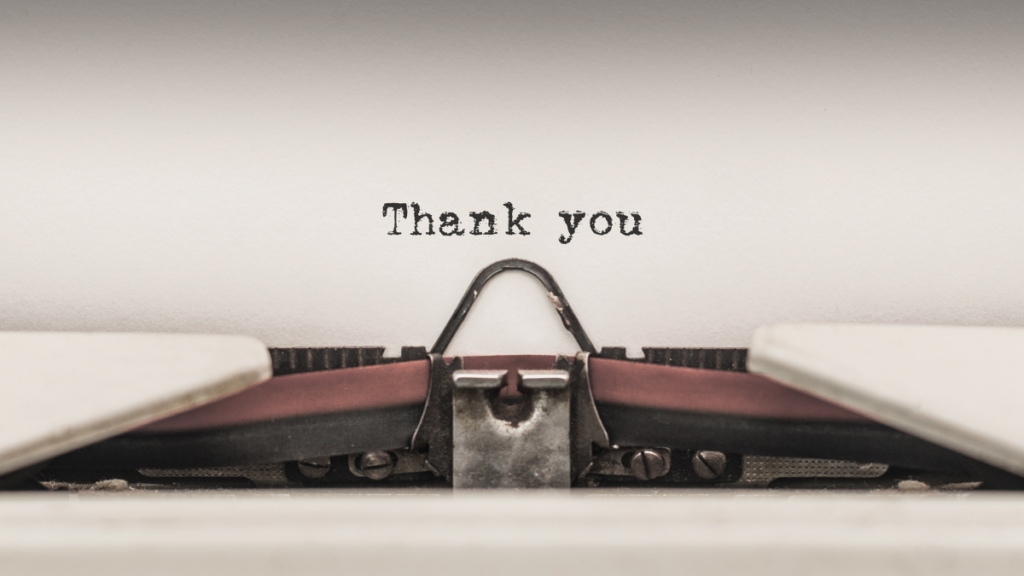It’s one of the very first things we teach our kids. While we’re teaching them “mama” and “dada“, we’ve already begun teaching them the sign (language) for “thank you.” Who doesn’t beam with pride when our little toddlers, when least expected to do so, throw out a surprise “thank you”? Fast forward to the tween years and there’s NOTHING that makes a parent prouder than another adult commenting on how “polite” your child is. When thank you begins to come automatically.
Fortunately, most adults have perfected the obligatory thank you, and do so without even thinking about it. Of course it’s great that they’re saying thank you, and expressing appreciation. But most of us walk mindlessly through our lives, dishing out the thank you’s, without stopping to feel even a hint of true appreciation, nor acknowledging the impact that your words may have on another individual. It’s time to start making the most of your THANK YOU’S.
In 2003, a famous study by Dr. Robert Emmons and Dr. Michael McCullough provided evidence for the benefits of practicing gratitude on mental (well-being, optimism and life satisfaction) and physical health (fewer physical symptoms). This was a study of the person BEING GRATEFUL. What about the person on the receiving end of that expression of gratitude?
A study conducted by researchers Adam M. Grant and Francesca Gino titled “A Little Thanks Goes a Long Way” found that expressing THANKS towards another not only benefits the person expressing gratitude, but also has a positive impact on recipient, leading them to be more helpful and prosocial. This research highlights the importance of acknowledging and appreciating the efforts of others.
In a world and workplace that feels so disengaged and divided, why aren’t we using this simple idea to build connection, foster a sense of appreciation and trust, and build teams and communities that continue to take advantage of this prosocial behavior? I honestly think we’re trying, but we’re missing the mark.
In today’s time-starved world, most of us are not all that good with THANKING. We’re thanking someone for what they’ve done for us while quickly passing in the hall. Or squeezing the phrase between two lines of text. Giving them the THANK YOU that they deserve isn’t difficult. But it must intentionally include these two components to be as effective as possible.
A reminder of what they specifically did, after the fact. “Thank you so much for your help last week with X, for doing Y…” This shows that their kind action had a lasting and memorable impact on you, whether at work (during a monthly check-in) or at home (while chatting with a friend).
A short description of how it made your life easier or better. This is the secret sauce. “Thank you so much for your bringing me up to date on that project yesterday. It really shortened my learning curve and I feel so much clearer about what we’re working on, thanks to you.” This not only shows how their actions had an impact on you, but forces you to stay with the feeling of gratitude for a minute or two.
These are simple, yet incredibly effective ways to make the most of a THANK YOU. By stopping to “marinate” (as famous neuropsychologist Rick Hanson says) in the gratitude, we’re rewiring our OWN brain to see more good in others. The recipient? Well they feel valued by the individual, team or organization. Both individuals are being bombarded with an onslaught of “feel good” neurochemicals, including oxytocin, which promotes feelings of trust and connection. And as we know in today’s fast-paced and virtual world, trust and connection are hard to come by.
In a world where we’re living on autopilot and gratitude often flows mindlessly, it’s time to take a pause. Yes, we must continue to express appreciation where appreciation is due. But by making a few small tweaks in the way we do so, we have the ability to directly impact the well-being of ourselves and those around us. We are able to deepen both connection and trust within our communities and workplaces. And with this SIMPLE act (and one that we don’t need an app for), we have the power to transform cultivate a more compassionate and engaged world.
